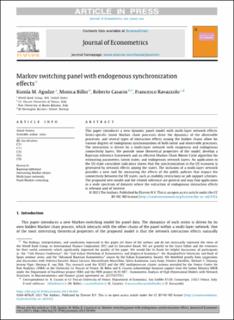Markov switching panel with endogenous synchronization effects
Journal article, Peer reviewed
Published version
Permanent lenke
https://hdl.handle.net/11250/3043411Utgivelsesdato
2021Metadata
Vis full innførselSamlinger
- Scientific articles [2181]
Sammendrag
This paper introduces a new dynamic panel model with multi-layer network effects. Series-specific latent Markov chain processes drive the dynamics of the observable processes, and several types of interaction effects among the hidden chains allow for various degrees of endogenous synchronization of both latent and observable processes. The interaction is driven by a multi-layer network with exogenous and endogenous connectivity layers. We provide some theoretical properties of the model, develop a Bayesian inference framework and an efficient Markov Chain Monte Carlo algorithm for estimating parameters, latent states, and endogenous network layers. An application to the US-state coincident indicators shows that the synchronization in the US economy is generated by network effects among the states. The inclusion of a multi-layer network provides a new tool for measuring the effects of the public policies that impact the connectivity between the US states, such as mobility restrictions or job support schemes. The proposed new model and the related inference are general and may find application in a wide spectrum of datasets where the extraction of endogenous interaction effects is relevant and of interest.

